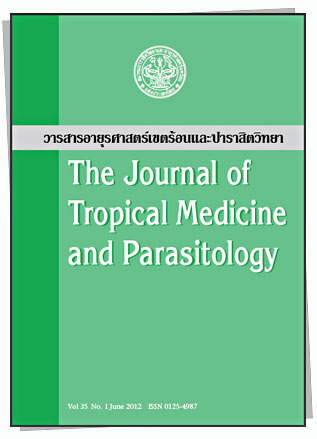Houseflies: a Possible Transport Host of Angiostrongylus sp
Main Article Content
Abstract
Abstract
Angiostrongylus, one of the metastrongylid worms, is known to be pathogenic to humans. Humanangiostrongyliasis can be caused by eating raw or improperly cooked land snails containinginfective larvae, eg, Pila sp, Pomacea sp, Achatina sp, which may all serve as intermediate hosts.Angiostrongylus infection has also been reported among travelers returning from the Caribbean; itwas concluded that infection occurred after they had consumed a vegetable salad contaminated withinfective-stage Angiostrongylus embedded in mucus. In June 2010, we visited a field station in Kanbaukarea, Yebhyu Township, Dawei District, Tanintharyi Division, in the Union of Myanmar. At the fieldstation, many houseflies were seen around the canteen, auditorium, living room, and work areas.Thence, 468 houseflies were caught manually using clean plastic bags. After collection, they werestored in formalin detergent and transported to the laboratory in Bangkok, Thailand, for parasiteexamination. After washing with an ultrasonic cleaner, mites, unknown nematode larvae, and 12larvae with prominent chitinous rods at the anterior end and constricted-tails – the morphologicalfeatures resembling infective Angiostrongylus larvae – were detected from the wash sediments. DNAidentification showed the larva was a metastrongyloid, with a 16.86% genetic differentiation fromA. cantonensis. This finding indicated houseflies are able to carry the infective stage of the worm, andact as transport hosts for metastrongyloid larvae. It is possible that houseflies can also be a transporthost of Angiostrongylus, the lung worm, with known medical significance to man.
Keywords: housefly; transport host; metastrongyloid; Angiostrongylus
